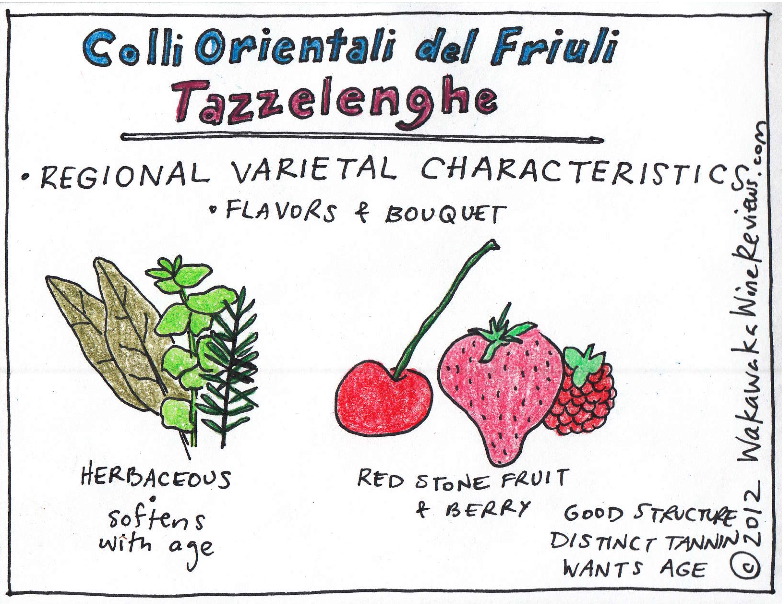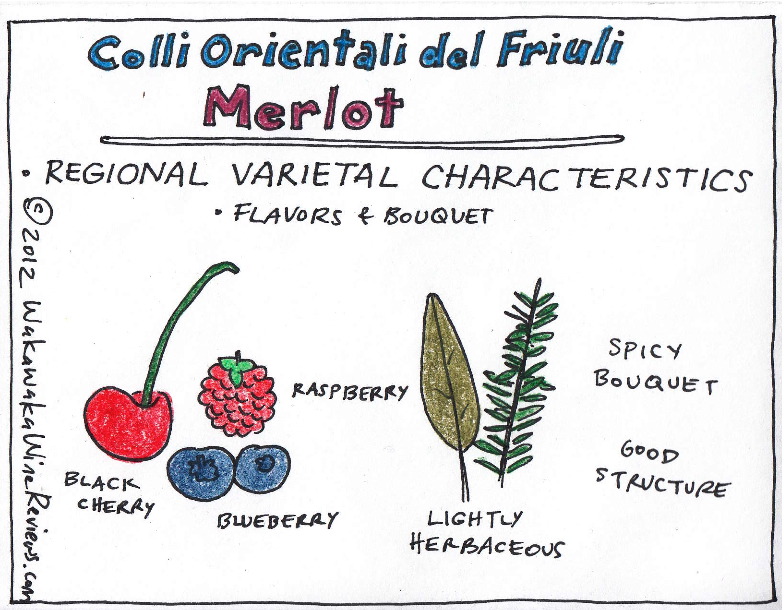Grapes of Colli Orientali del Friuli
The earth of appellation of Colli Orientali del Friuli, along the Slovenian border of Italy, hosts a mineral rich marl that is unique not only because of its blue color (all except in one part of the appellation where it is red), but also because of its high calcium content. The soil offers a rich minerality to the wines of the region that often shows as either a faintly salty quality, or a precise and dry slate.
Sitting along the intersection point of the Alps with the Balkans, just a few kilometers above the Adriatic, Colli Orientali del Friuli generally carries a mix of Mediterranean with Alpine climate–a cool, fairly mild and well-regulated temperature range with drying winds.
The combination of the soil and climate of the region intersect to produce unique characteristics for international grapes, and excellent growing conditions for grapes not seen any where else.
Indigenous Varieties
Tasting through Colli Orientali del Friuli hits all my love-for-obscure-grape buttons, as the region particularly celebrates its indigenous varieties. As Paolo Rapuzzi explained, the area once hosted over 150 grape types local to the region but after the phylloxera epidemic international varieties were planted instead replacing the original native plants.
In fact, Italian wine history includes the demand for focus on international varieties only into the 1970s when the Rapuzzi family helped fight the regulations to allow for grape farmers to grow indigenous vines without fine. Today, Colli Orientali has a huge focus on the local plants with a great pride in continuing to cultivate and bottle their wines.
Schioppettino
click on comic to enlarge
We were lucky enough to taste through a wealth of Schioppettino, one of the group’s favorites of the wine types explored during our week-long visit to the region. The grape is still today predominately grown only through Friuli, though some few wine makers have begun to experiment with growing the variety in California in small quantities.
The Colli Orientali Consortium celebrates an association of wine makers in Prepotto–the village where Schioppettino is believed to have originated–dedicated to cultivating the best in quality for the variety. The Association of Prepotto Schioppettino Producers hosted a dinner for us during our trip where we tasted at least 15 different presentations of the varietal, and one Schioppettino-Refosco blend. To read more on the evening and the variety check out Do Bianchi’s post here: http://dobianchi.com/2012/04/10/schioppettino-the-next-big-thing-history-of-its-revival-and-fortune/
At its best, Schioppettino is a beautifully balanced, and elegant wine carrying a mix of fresh red and wild berries, alongside peppery notes, and light herbaceousness. It tends towards pleasing tannins with a smooth texture and bright acidity that cleans the mouth as you drink.
Refosco dal peduncolo rosso
click on comic to enlarge
As Paolo Rapuzzi explained to us, while Schioppettino really is only grown through the Friuli region, Refosco extends slightly into the surrounding areas as well. Part of the large Refosco family, Refosco dal peduncolo originates in Friuli, showcasing its best characteristics thanks to the conditions of the area.
Refosco is a grape of impressive strength with the characteristics for a stunning wine of good acidity and strong tannin both. It has all of the structure for excellent aging, and admittedly its strength can sometimes work against drinking it too young. However, several wine makers throughout Colli Orientali del Friuli showed us wines that took the balance of Refosco’s strength with a younger approachability. The fruit of this variety shows a mix of dark and red berries, alongside primary herbaceous notes.
Pignolo
click on comic to enlarge
Pignolo is a wine uncommon outside the Friuli region (though there is another variety from Lombardy that shares the same name but that most wine experts believe is not related (See 169 Oz Clark’s Encyclopedia of Grapes 2001)). I fell in love with its elegant intensity and nice balance of acidity with tannin. The flavors here are both fresh and rich showing red berries mixed with spice. The spice on these wines is known to develop greater sophistication with age.
Tazzelenghe
click on comic to enlarge
Least common of the indigenous varieties of Colli Orientali del Friuli, we were able to taste only one Tazzelenghe. The grape is so rare it is barely mentioned in even the most comprehensive of wine books. I count myself lucky to have tried an offering, and though uncommonly, there are some varietals of this grape imported to the United States, if you’re interested in trying one.
The primary characteristics of this grape are its herbaceous notes, which soften with age, showing as dominate to its ripe red stone and berry fruit. The wine gains greater balance as it ages, showcasing good structure and distinct tannin characteristics.
International Varieties
As dedicated to Indigenous varieties as the wine makers of Colli Orientali del Friuli are, they also produce several international varieties that develop their own profile unique to the region.
Merlot
click on comic to enlarge
Most common of the red international varieties to the area, Merlot bottles here as its own varietal, or as the anchor point for a number of the area’s red blends.
Cabernet Franc
click on comic to enlarge
Cabernet Franc holds a key role in the red international grapes for the region. It is produced both under its own full moniker, and as a local wine called simply, Cabernet (t is pronounced here). When presented as Cabernet, however, the wine may be either a full Cabernet Franc, or blended with its offspring Cabernet Sauvignon.
The variety carries a complicated history through the region, however. As has occurred with various grape varieties around the world, Cabernet Franc was widely planted through the region decades ago and then discovered to actually be Carmenere. Some believe that the wines of Friuli named Cabernet Franc are almost entirely Carmenere, showing the more vegetal qualities of that grape than what Cabernet Franc would tend to offer. Because of the history of naming and the establishment of the wine regulations through the area, however, the wine still appears under its original-to-the-region name, Cabernet Franc.
Cabernet Sauvignon
click on comic to enlarge
Cabernet Sauvignon only occasionally appears on its own in Colli Orientali as many wine makers choose to use it in blend with either Merlot, or Cabernet Franc instead of on its own. Though it produces a pleasing, full bodied red in the hills of this appellation, it is not commonly grown in Italy in general.
Pinot Noir
click on comic to enlarge
The least common of the international varieties in Friuli, Pinot Noir is also the hardest to grow due to dampness hugging in amongst the grape clusters. Still, some producers are dedicated to the variety and develop it at low levels out of love for the flavor and style it produces.
Copyright 2012 all rights reserved. When sharing or forwarding, please attribute to WakawakaWineReviews.com









[…] By Hawk Wakawaka. […]
[…] North as what was believed to be Cabernet Franc. It is now understood that most of what has been taken to be Cabernet Franc in areas like Friuli-Venezia Guilia and Veneto is actually […]
[…] Red Grape Varieties of Colli Orientali Friuli – Hawk Wakawaka Wine Reviews […]